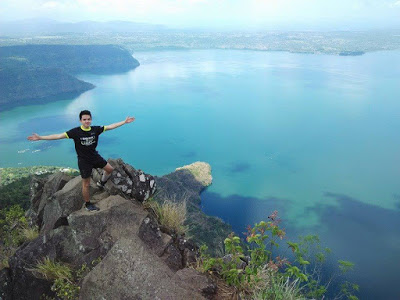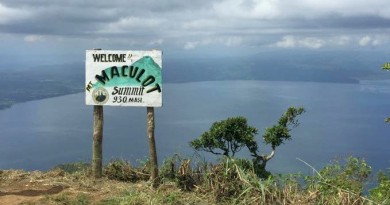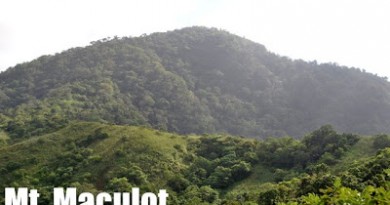Makulog—the Thor of Batangas
 |
| The author’s son, Xygy Cuevas, at Mt. Maculot’s Rockies |
by Arturo Cuevas
Founding Member, UST Mountaineering Club (1970)
Throw in a hand to rein in an astray that we may have helped unleash more than a quarter of a century ago. This is what this blog is all about.
In the early 1970s, the UST Mountaineering Club (later the Mountaineering Association of the Philippines) pioneered in organized mountain-climbing in the country. Our itineraries from those years and onwards to the 80s and 90s included Apo, Pulag, Tab’yo, Mayon, Isarog, Halcon, Bulusan, Cleopatra’s Needle, Cabayugan Half-Dome, Arayat, Banahaw, Makiling, and Sabah’s Kinabalu. And with Cuenca, Batangas, being my hometown, Mt. Makulot too was but of course on our list, mostly for the challenge of its West Wall dramatically rising from the shores of Lake Taal.
Back then, it was hard to imagine Makulot as the weekender’s destination that it has now become, along with all the concerns brought by the growth of the volume of human traffic up and down the mountain. We practically have the mountain to ourselves then, but share it we did along with our other adventures, in pictures and in published articles, hoping to inspire some kindred souls. Looking back, what may be our blunder was not firmly addressing the problems and issues, primarily environmental, of mountain-climbing becoming popular.
A mountain’s lore
Education on what the mountains are and what they represent, should perhaps contribute on how to handle this opened Pandora’s Box—to make climbers realize that their place of visit is worth all the respect as their very own homes. Mt. Makulot, for one, is steeped in lore but much of it is little-known, and recounting some may lend some more esteem to this popular trekkers’ mountain.
The mountain’s name, for one, remains an intriguing mystery to most, including the younger generation among locals. There are two schools of thought as to why the name “Makulot.” One is that it is a derivative of makulog (thunder-filled or thunderous). Just a single experience of the reverberating crescendo of a thunderstorm in Cuenca should more than explain this makulog appellation.
Another belief is that the name Makulot simply came from a wild shrub quite common in the area which locals call kulutan. These wild plants are hard to miss; what with their rounded seeds growing Velcro-like appendages and sticking to the clothing (and even bare skin) of passers-by.
Also well-acquainted among visitors of the mountain are the tall cogon grasses on some of Makulot slopes, particularly where campers overnight nowadays. I distinctively remember as a kid that that these grasses were deliberately set on fire occasionally. The young grass shoots post-fire make for good cattle fodder, and in the old days, local folks say, the mature grasses are gathered for cogon thatch roofing.
Enchanted golden bull
As in any other Philippine mountain, Makulot too has its own distinct folklore, in much the same way that Makiling has its Mariang Makiling, Arayat its Mariang Sinukuan, and Mayon its Daragang Magayon. Only, the symbolism is of the masculine genre for Makulot which local legend says is home to a “torong ginto” or golden bull lording among the native encantos or enchanted ones whose haunts extend all the way to the Taal Volcano-island, making their presence felt whenever there is a display of thunder and lightning at the cloud-shrouded slopes of Makulot and its west wall.
The geological history of the mountain is also as fascinating. Makulot is volcanic in origin. Geologists believe that Taal Lake was once the caldera of a monstrous pre-historic volcano, and Mt. Makulot was formed by one of its many unrecorded eruptions; hence, there is this spectacular Makulot West Wall rising all the way down from the lake. It has also been observed that it is Mt. Makulot, especially its West Wall, which has shadowed and protected the town of Cuenca from the recent eruptions of present-day Taal Volcano.
Thunder of the Gun of Makatmon
Visiting climbers call the top of the Makulot West Wall, the “Rockies.” But to us locals, it’s known by the more intriguing “Indulanin” (which research tells me is a song or lullaby). And the shoulder-like campsite east of these rocky outcrops is called “Makatmon,” a ridge which earned some quaint place in World War II history.
Old folks of Cuenca recall that the Japanese imperial army bracing for the “Liberation” of the Philippines and General Macarthur’s landing in Luzon, hauled one of the biggest cannons in Japan’s armory all the way to Makulot’s Makatmon. There, the Japanese, using forced labor, dug complex tunnels ala Iwo-Jima, and installed this humongous cannon on rails leading to one of those tunnels, which brings to mind the classic war film Guns of Navarone.
For a while, so the town’s old-timers say, the Japanese and their cannon at the Makulot/Makatmon ridge vantage point had a field day taking pot shots at the Americans who by then have landed at the Batangas and Balayan Bays. The Americans bombarded Makulot with their own artillery and heavy aircraft bombers. But the Japanese cannon kept on firing, eluding US spotter planes from taking a fix of its location by simply retreating into its tunnel immediately after giving the Americans a barrage of fusillade.
My math teacher in the Cuenca high school I attended told us that applying physics to the situation was what saved the day for the US forces. By patiently observing with binoculars the cannon’s smoke after each barrage, factoring in the time of impact and sound blasts, he said that the GIs finally took a bearing or an estimated fix of the position of the Mt. Makulot cannon. And to the Americans’ credit, or just by sheer luck, their time-and-motion computations were so accurate that the American artillery hit the cannon-on-rails right on its barrel before it could reach the safety of its tunnel-nest.
Hopefully, these vignettes on Makulot can contribute toward a more interesting and enriching climbing experience, and as important, elicit a firmer commitment and obligation to the visitor to keep the mountain as it has been before. For who knows? Amid the mountain’s thunder and lightning, there may be this golden bull and its encanto troops charging along, or in moonless nights, some ghosts of Japanese soldiers may still be there, straggling in a vain search for the cannon they’ve unknowingly lost.
With these rambling thoughts, therefore, wouldn’t it be a fitting preamble for those planning a climb to this mountain that where they’re headed is a marvelous visit to the home of “Makulog,” the Batangueños’ very own Thor?
Contributions and guest posts are welcome in Pinoy Mountaineer. Send your submissions at info@pinoymountaineer.com.





Leave a Reply
6 Comments on "Makulog—the Thor of Batangas"
Regarding the guide fees . . . my suggestion is touch base via Facebook with Ms. Pilar Andrea Dimaculangan. She was the organizer (and my high school classmate) of the Mt. Maculot Technical Rescue Group which facilitated the rescue of the victims in the recent helicopter crash in Makulot. I believe many of the members of this volunteer rescue group are guides or have friends and relatives who are. Being a native of the town,I know our folks are very considerate, especially if the climbers are students with tight budgets. Many would even invite strangers to their humble homes, saying "Ala eh, sinsay muna kayo dine at makapagkape." For more information about these Makulot rescue group, you may visit this site (with apologies to Gideon for attaching a link).http://manila.coconuts.co/2015/07/15/brave-and-honest-men-cuenca-and-theres-plenty-more-where-came-0
Regarding the guide fees . . . my suggestion is touch base via Facebook with Ms. Pilar Andrea Dimaculangan. She was the organizer (and my high school classmate) of the Mt. Maculot Technical Rescue Group which facilitated the rescue of the victims in the recent helicopter crash in Makulot. I believe many of the members of this volunteer rescue group are guides or have friends and relatives who are. Being a native of the town,I know our folks are very considerate, especially if the climbers are students with tight budgets. Many would even invite strangers to their humble homes, saying "Ala eh, sinsay muna kayo dine at makapagkape." For more information about these Makulot rescue group, you may visit this site (with apologies to Gideon for attaching a link).http://manila.coconuts.co/2015/07/15/brave-and-honest-men-cuenca-and-theres-plenty-more-where-came-0
Always nice to read the history of a mountain and its etymology.
Will be climbing Mt. Maculot on August 1. Do you have any idea po kung pwedeng i-haggle yung guide fee dun? Or do you know a guide na pwedeng ihaggle ang price niya? 🙂 we'll be doing a traverse sana 🙂 Thanks po! 🙂
tunnels in maculot. we tried exploring beyond the summit trails on one of our dayhikes traversing maculot. in a water trail towards the edge of the summit going the lakeside, we passed by atleast two dugged up cave like holes.it could be part of the tunnel network, we didnt explore inside since it was mosquito infested that time.